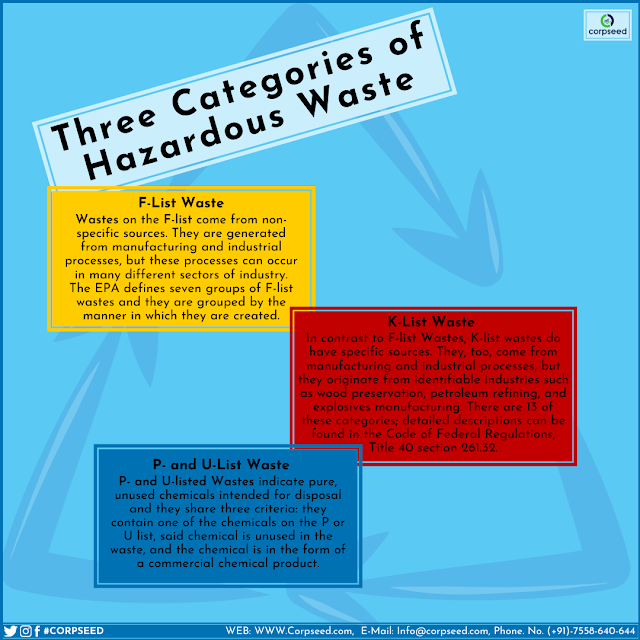The process of disposing of Hazardous
and Non-hazardous waste can vary widely. Therefore, it is important
to know what is and what is not considered hazardous waste. EPA defines three
types of hazardous waste: Listed, Distinctive, and Mixed Radiation Waste. Each
of these categories has subcategories that can be very specific, but the basic
ones are as follows.
Listed waste:
The wastes listed are those that originate from
identifiable manufacturing processes and industries, or that may be chemical
wastes from commercial products. There are four types of wastes listed: F, K,
P, and U wastes.
List
F wastes
List F wastes come from non-specific sources. They are
created from industrial and manufacturing processes, but these processes can
take place in many different industries. EPA defines seven groups of List F
wastes and they are grouped according to how they were generated.
List
K wastes
Unlike List F wastes, List K wastes have specific
sources. They also come from industrial and manufacturing processes, but they
come from identifiable industries such as wood preservation, petroleum
refining, and explosives manufacturing. There are 13 of these categories; See
the Code of Federal
Regulations, Title 40, Section 261.32 for detailed descriptions.
Residuals
of lists P and U
Wastes listed P and U indicate pure and unused chemicals
that are destined for disposal and have three criteria in common: They contain
one of the chemicals on the P or U list, so the chemical in the waste does not
is used and the chemical is in the form of a commercial chemical.
List P waste is serious waste and its empty packaging is
treated as hazardous waste. U-list wastes are also toxic, but empty containers
are not considered hazardous.
Characteristic
residues:
Characteristic residues are defined as having at least
one of the following properties: flammability, corrosivity, reactivity, and
toxicity.
Flammable: waste that can catch fire. Wastes of this
grade include compressed gases, solid wastes subject to spontaneous combustion,
and liquids with flash points below 60 ° C.
Corrosive: residue that can corrode another substance
through chemical reactions. Hazardous wastes of this grade include liquid
wastes with a pH of 2 and less or 12.5 and more. Corrosion can also be due to
the substance's ability to corrode steel.
Reagent: unstable residue under typical conditions. These
hazardous wastes can react chemically with water or explode when exposed to
heat. Explosives and lithium-sulfur batteries are considered reactive hazardous
waste.
Toxic: harmful or fatal waste if ingested or absorbed by
living beings. Examples of hazardous toxic wastes are arsenic and chloroform.
For a complete list of toxic wastes and the legal requirements that classify
them as hazardous.
Mixed
radiological waste:
The last category of hazardous waste is mixed
radiological waste, which means that the waste contains both a hazardous
component and a radioactive component. Since it contains two types of regulated
waste, the disposal of mixed radiological waste must comply with RCRA and the
Atomic Energy Act. It is the Ministry of Energy or the Nuclear Regulatory The commission that regulates the radiological part of this hazardous waste.
It can be difficult and time-consuming to determine
whether or not your business produces hazardous waste, what category it falls
into, and how it is disposed of properly. For help with regulatory compliance
and Hazardous
Waste Disposal, Contact Corpseed for a quick, free quote.


0 Comments